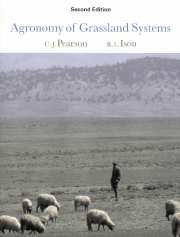Book contents
- Frontmatter
- Contents
- Preface
- 1 Overview: perspectives on grassland systems
- 2 The emergence of grassland systems
- 3 Generation
- 4 Vegetative growth
- 5 Flowering and seed production
- 6 Mineral nutrition
- 7 Herbage quality and animal intake
- 8 Grassland – animal interactions and management
- 9 Grassland systems design
- References
- Index
2 - The emergence of grassland systems
Published online by Cambridge University Press: 05 June 2012
- Frontmatter
- Contents
- Preface
- 1 Overview: perspectives on grassland systems
- 2 The emergence of grassland systems
- 3 Generation
- 4 Vegetative growth
- 5 Flowering and seed production
- 6 Mineral nutrition
- 7 Herbage quality and animal intake
- 8 Grassland – animal interactions and management
- 9 Grassland systems design
- References
- Index
Summary
The title of this chapter follows the perspective we presented in Chapter 1: that grassland systems are socially constructed. They are thus an emergent property (Table 1.1) of socio-cultural processes that have a history and traditions. As Russell and Ison (1993) note, ‘every model of understanding grows out of a tradition – a network of prejudices (literally understood as a pre-understanding) that provide possible answers and strategies for action’. A ‘tradition’ here is taken to mean a pervasive, fundamental phenomenon that might be called a ‘way of being.’ Here we explore traditions of understanding that have resulted in the emergence of particular grassland sytems.
Through research, scholarship and stories, sometimes called creation myths (Knudsen & Suzuki, 1992), we recognize that grassland systems existed prior to the evolution of humans (Homo sapiens sapiens). Hominids engaged in hunting and gathering at least 2 million years ago (Fagan, 1986). Socially constructed grasslands began, by our definition, when humans with fully developed brain and speech appeared some 50 to 250 000 years ago (Table 2.1). Fire and other forms of manipulation of herds of herbivores were some of the first ‘grassland management’ tools; grass fires destroy old vegetation and game are attracted to the fresh growth. Many of the early nomads followed the migratory routes of the large herds of herbivores, such as the wildebeest of east Africa and the reindeer of northern Europe. Nomads moved from pasture to pasture: the word ‘nomad’ is derived from the Greek word ‘nomos’, meaning pasture.
- Type
- Chapter
- Information
- Agronomy of Grassland Systems , pp. 18 - 36Publisher: Cambridge University PressPrint publication year: 1997



